Enhancing Bedroom Aesthetics with Mirrors
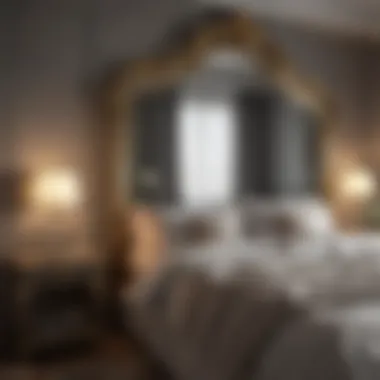
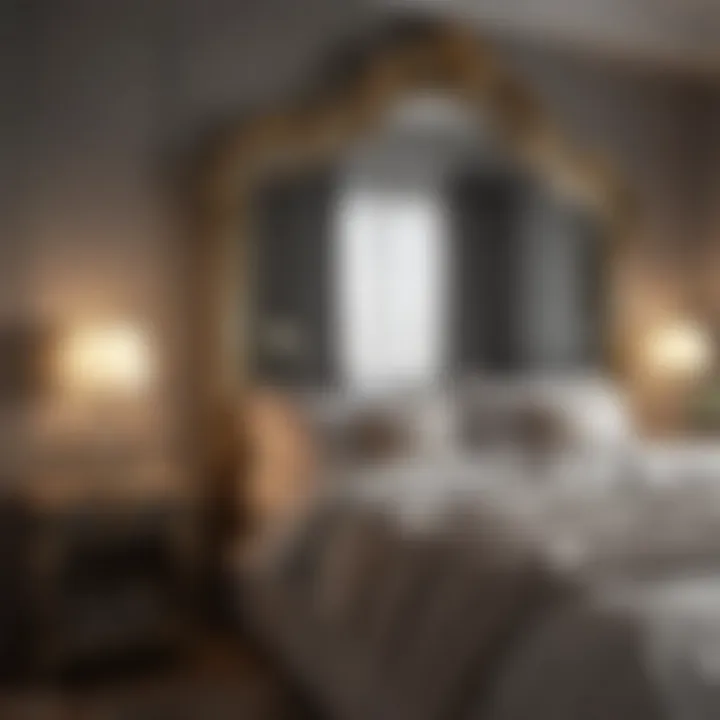
Intro
Mirrors are more than simple glass and metal frames; they hold the potential to reshape the entire atmosphere of a bedroom. From reflecting light to creating the illusion of space, these surfaces play a dynamic role in design. When integrated thoughtfully, mirrors provide not just aesthetic appeal but also a sense of functionality that can enhance any bedroom setting.
In this guide, we are set to explore how mirrors fit into the aesthetics of bedroom design. We will delve into various aspects, such as placement strategies, stylistic options, and the psychological impact of different mirror shapes and sizes. This knowledge will empower you to effectively weave mirrors into your bedroom’s overall aesthetic and ambience.
Design Inspirations
Latest Trends in Bath and Bedroom Design
The recent design trends highlight a move towards minimalism and natural elements. Mirrors nowadays are not just reflective surfaces; they are central pieces that can either blend seamlessly into the backdrop or stand boldly as a statement piece. For instance, frameless mirrors offer a clean, uninterrupted look, while vintage or ornately framed mirrors can bring a hint of nostalgia and character into the room.
"In contemporary interiors, mirrors have evolved into art pieces, enhancing beauty and sparking conversation."
Another growing trend is the use of oversized mirrors. These can be particularly striking and create a visually expansive feel. They can make a small room appear larger, reflecting light from windows and brightening every corner. When placed opposite a window, oversized mirrors can double the natural light, making the bedroom glow.
Color Palettes and Themes
Color plays a vital role when choosing mirrors. A mirror’s frame color should harmonize with your existing palette. Dark, dramatic frames can accentuate bold colors while lighter frames can complement softer, pastel hues.
In themed bedrooms, such as coastal or bohemian, mirrors can enhance the overall aesthetic. For instance, a rattan-framed mirror perfectly aligns with beach vibes, while intricate patterns in a Moroccan-style mirror can add depth and interest to eclectic designs.
Functional Elements
Space Optimization Tips
Mirrors can work wonders for space optimization in a bedroom. Placing mirrors beside or behind furniture can trick the eye and stretch the feel of the space. This is especially useful in smaller rooms where every inch counts.
Furthermore, using mirrored furniture, such as a mirrored nightstand, can help reflect light and make the space feel open and airy. It’s clever to pair light-colored furnishings with mirrors to maximize brightness; this combo tends to feel more inviting and spacious.
Multi-Functional Furniture Choices
In the realm of design, functionality is key. Using mirrors as part of multi-functional furniture can yield both space and style. For example, a mirrored wardrobe not only offers storage but adds a decorative element to the room. These pieces can help keep your space decluttered while still looking aesthetically pleasing.
Additionally, utilizing mirrors on sliding doors provides convenience and serves as an illusion that brings depth to your bedroom, making the atmosphere feel larger than life.
The dialogue around mirrors never ends. Their significance only grows as design philosophies evolve, making it worthwhile to stay updated. As you embark on your journey of enhancing your bedroom, remember that the right mirror can be the finishing touch that can pull the entire design together.
Prelims to Mirrors in Bedroom Design
When it comes to bedroom design, mirrors play a role that often flies under the radar. It’s much more than just a reflective surface; mirrors can reshape the ambiance of a room, influencing both the aesthetic and practical functions within a space. With the right placement and selection, mirrors can create an illusion of spaciousness, invite light, and serve as a decorative focus that adds personality to a bedroom. Their importance lies in the ability to harmonize various design elements, enhancing not just the look but also the feel of a room.
Historical Context of Mirrors
Mirrors have fascinated people throughout history. Their journey dates back thousands of years, starting from hand-held polished stones used by ancient civilizations. Egyptians had glass mirrors made of bronze, while Romans crafted them from blown glass. Fast forward a few centuries, and mirrors became a symbol of wealth and status during the Renaissance. The more ornate and elaborate the mirror, the greater the prestige it conferred upon the owner. Today, while mirrors are ubiquitous and often mass-produced, some styles harken back to those opulent designs -- think of intricately framed mirrors that evoke a sense of timeless elegance.
Cultural Significance of Mirrors in Bedrooms
Mirrors often carry deeper meanings that transcend mere functionality. In many cultures, they symbolize self-reflection, both literally and metaphorically. In Feng Shui, for example, mirrors are used with caution as they are believed to reflect energy. Placing a mirror in a bad position could disrupt the flow of positive energy in a room. In contrast, Western traditions tend to view mirrors as a tool for enhancing aesthetics and social interactions. The act of checking one’s appearance reflects not only on self-image but also on societal standards of beauty. Thus, incorporating mirrors into bedroom design can bridge personal identity with cultural narratives, making them not just decorative items but also vessels of meaning.
The Aesthetic Impact of Mirrors
Mirrors can fundamentally alter the look and feel of a bedroom. They serve not just as practical tools for checking one's appearance but also as artistic elements that significantly enhance a room's aesthetics. A well-placed mirror can create a sense of openness, reflect light, and contribute to the overall theme of the decor. When integrated thoughtfully, mirrors can bridge the gap between beauty and functionality in a space that is often used for relaxation and rejuvenation.
Enhancing Light and Space
One of the prime functions of mirrors in any interior space is their ability to amplify light. In small or dimly lit bedrooms, a carefully positioned mirror can work wonders. By reflecting natural light from windows or lamps, mirrors can create an illusion of depth and brightness, making a room feel more spacious and airy. This is especially beneficial for bedrooms that lack natural illumination.
When choosing a mirror, consider the following:
- Direction of Light: Place mirrors opposite windows to effectively bounce light around the room.
- Proportional Sizes: A large mirror can dominate a small room, so balance it with the room's proportions. A slim mirror can elongate the space without overwhelming it.
- Design Choices: The frame and shape of the mirror can contribute to how light is perceived. A round, ornate mirror can soften harsh lines, adding warmth to the space.
"Mirrors act as portals of light and space; they tell the room's story by reflecting what is present."
Creating Focal Points
Another significant role of mirrors is their capacity to serve as focal points in bedroom design. A well-placed mirror not only draws attention but also adds layers to the aesthetic experience of the room. The way light plays off the glass and the reflection it produces can create a stunning visual effect.
Here’s how to effectively utilize mirrors as focal points:
- Choose Unique Designs: Look for mirrors with interesting shapes or artistic frames. A vintage mirror can evoke nostalgia, while a modern design can suggest minimalism.
- Strategic Placement: Position the mirror above a striking piece of furniture, like a bedside table or a dresser. This can create a cohesive look that ties elements of the room together.
- Reflective Surfaces: By ensuring your mirror reflects a beautiful view, artwork, or charming design feature, you enhance the visual interest in the overall setup.
In summary, mirrors do much more than reflect your image; they can redefine a room's atmosphere and aesthetic. Their ability to enhance light and create captivating focal points makes them invaluable in bedroom decor.
Functional Benefits of Mirrors
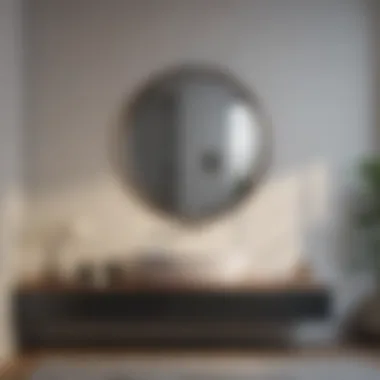
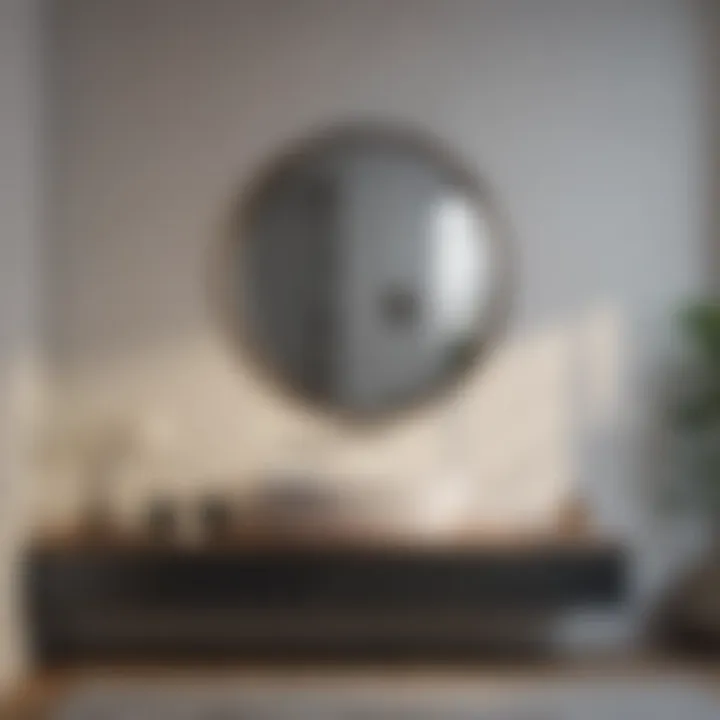
Mirrors are often celebrated for their aesthetic charm; however, their practical applications in our daily lives are equally significant. When reflecting upon the functional benefits of mirrors in bedrooms, one discovers how these objects serve beyond mere decoration. They become integral components in daily routines, influencing both efficiency and self-perception.
Practical Uses in Daily Routine
A mirror’s primary function is the display of one’s reflection, but its role extends to enhancing the effectiveness of our daily rituals. Whether you are rushing to prepare for the day or winding down after a long one, mirrors guide us through our routines. Here are a few practical benefits:
- Adjusting Lighting: Mirrors can brighten up a dimly lit corner. Strategically placing a mirror opposite a window allows natural light to bounce around the room, creating a warm, inviting atmosphere. This not only serves to illuminate the space but also uplifts one's mood as daylight enters.
- Visual Clarity: They help check one's appearance before heading out. Having a good-quality mirror within reach makes it easy to assess everything from outfits to makeup, ensuring that you leave the house looking your best.
- Creating Space: For small bedrooms, a well-positioned mirror can create an illusion of a larger environment. It tricks the eye and makes a snug room feel airy and expansive.
Without doubt, mirrors serve as handy tools that aid in completing daily tasks more effectively.
Aid in Dressing and Grooming
This brings us to perhaps the most evident benefit of mirrors: their role in dressing and grooming. A well-placed mirror is a dependable ally when you are preparing for the day ahead or gearing up for a night out.
- Outfit Coordination: Using a full-length mirror allows individuals to visualize the entirety of an outfit. Mixing and matching pieces becomes easier, and one can easily see what styles flatter or don’t. This also fosters a sense of confidence as one’s appearance is constantly checked and adjusted.
- Self-Reassurance: Mirrors can bolster one's confidence. When individuals take an extra moment to appreciate their appearance, it often leads to a positive self-image. Standing tall and confident in front of a mirror empowers choices in wardrobe and persona.
- Makeup Application: For those who enjoy optimizing their beauty routines, mirrors serve as indispensable tools. A detail-oriented makeup user values a clear reflection to ensure precision, from eyeliner application to lipstick placement.
As such, it's clear how mirrors influence not only how we see ourselves but also how we engage with our daily tasks and routines.
"Mirrors are not only reflections of the outside, but they can also shape how we perceive ourselves internally."
Integrating mirrors thoughtfully into your bedroom, goes beyond surface-level aesthetic choices. They play a vital role in making daily life smoother and more enjoyable.
Varieties of Mirrors for Bedrooms
When it comes to enhancing a bedroom's aesthetics, selecting the right type of mirror is essential. The varieties of mirrors available can significantly change the overall vibe and function of a space, catering to both practical needs and design preferences. Different styles serve distinct purposes, and understanding each can help homeowners make informed decisions that elevate their interiors.
Wall-Mounted Mirrors
Wall-mounted mirrors are among the most favored choices in bedroom decor. These mirrors save precious floor space, making them perfect for smaller rooms or areas that require a more open feel. They come in an array of shapes, sizes, and styles, allowing for creativity while adhering to a bedroom's existing theme.
One important aspect to consider with wall-mounted mirrors is their height and placement. Mounting a mirror too high or too low can distort its functionality, making it hard to see one's reflection fully. An ideal height often aligns with the eye level of its primary user. In addition, arranging these mirrors above dressers or nightstands can create balance and harmony, pulling together the room's layout.
"Mirror placements can do wonders in a room. It’s all about finding the sweet spot that turns an ordinary wall into a stylish focal point."
Freestanding Mirrors
Freestanding mirrors bring a touch of sophistication to any bedroom, offering a full-length view that's indispensable for dressing. Their versatility allows for easier relocation compared to wall-mounted options, meaning owners can change their bedroom's layout without much effort.
These mirrors often feature elaborate frames, adding character. They can act as statement pieces, drawing the eye and serving not only as practical tools but also as art. Positioning a freestanding mirror strategically can enhance natural light, reflecting it across the room and creating an illusion of a larger space. Moreover, placing them near windows maximizes brightness, which can lift the mood and overall ambiance of the room.
Decorative Mirrors
Decorative mirrors serve as more than just reflective surfaces; they are integral components of a bedroom's decor. These mirrors can embody various styles, from vintage glam to modern minimalism.
Designs vary greatly, and these mirrors might include ornate frames, etched details, or clever shapes like sunbursts or geometric patterns. Their placement can significantly affect how a room feels; for example, a large, decorative mirror can open up cramped spaces, while clustered smaller mirrors can create a visually striking gallery wall.
When incorporating decorative mirrors, it’s wise to think about the surrounding decor and color schemes to ensure they complement rather than clash with existing elements.
Key considerations regarding decorative mirrors:
- Color: Match or contrast with room palette.
- Shape: Round, square, or abstract shapes can all convey a different feel.
- Frame: A unique frame can turn a mirror into a showpiece, rather than just a functional item.
Culmination
Choosing the right type of mirror transforms a bedroom's aesthetics while fulfilling practical needs. Wall-mounted, freestanding, and decorative mirrors each serve their purpose, allowing homeowners to explore their style preferences. Remember to consider key elements like placement and surrounding decor to maximize their impact. In the end, the perfect mirror can harmonize functionality and form, leading to a refined, personalized space.
Mirror Placement Strategies
In the realm of bedroom aesthetics, the way mirrors are placed can make all the difference between a space that feels cramped and one that exudes openness and tranquility. Mirrors serve not just as functional elements for checking one’s appearance; they play a pivotal role in maximizing light penetration and adding depth to a room. Proper placement can entirely shift the atmosphere, ensuring the bedroom is a haven of relaxation.
The strategic positioning of mirrors involves various considerations, such as factors of light, reflection, and the overall theme of the interior. An informed approach can enhance the beauty and functionality of the space while creating a soothing environment for its inhabitants. A well-placed mirror reflects not just light, but also a sense of balance and calm.
Ideal Locations for Maximum Impact
When it comes to selecting the right spots for mirrors, there are several key locations that can optimize their benefits:
- Across from Windows: Placing a mirror directly across from a window can magnify natural light, making even the slightest rays look magnified. This approach is particularly beneficial in spaces that may receive less light, such as north-facing bedrooms.
- Above Dressers: A classic choice, this pairing brings together function and style. Not only does it provide a full-length view for dressing, but it also adds visual height to the room thanks to the layered effects of reflection.
- In Nooks: If your bedroom has a reading nook or small corner, consider a rounded or unique-shaped mirror – they add charm and character, making the space feel more inviting.
- At Bedside: An unusual placement, but not without merit. A small decorative mirror on a bedside table can act as a playful accent, introducing reflective elements that keep the area looking fresh.
"A mirror’s placement is a dance with light; get it right, and the whole room sings."
- Attached to Closet Doors: Utilize storage efficiently by opting for mirrored closet doors. This creates an illusion of space while offering a practical grooming solution.
The bedroom's layout can dictate the effectiveness of these placements, and it’s worth experimenting with slight adjustments to see what looks best for your unique space.
Avoiding Common Mistakes

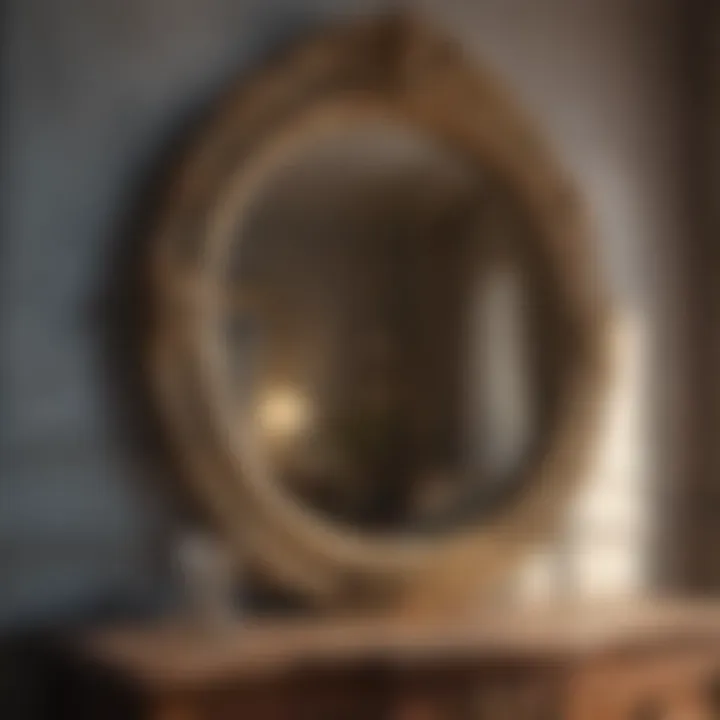
Achieving the perfect mirror effect requires an awareness of common pitfalls that can undermine the overall aesthetic:
- Overcrowding a Space: Too many mirrors can overwhelm the eye and make the room feel chaotic. Try to limit the number of reflective surfaces to choose key locations that will enhance rather than clutter.
- Ignoring Scale and Proportions: A huge mirror in a tiny room can dwarf the space, while a small mirror in a grand bedroom may feel lost. Choose mirrors that balance the size of the furniture and the room itself.
- Reflections of Chaos: Be mindful of what a mirror reflects. If it shows a cluttered area, it can create visual distraction. Aim to reflect clean spaces or nice views to maintain a serene atmosphere.
- Dimming Natural Light: While reflections are beautiful, placing a mirror where it can block light from entering through a window actually defeats its purpose. Ensure mirrors are set in positions that enhance brightness.
In summary, mirror placement is not merely about finding a wall space; it involves a careful thought process aimed at maximizing the visual and emotional benefits a mirror can bring. By focusing on ideal locations and avoiding common errors, one can create a bedroom sanctuary that feels both expansive and welcoming.
Psychological Effects of Mirrors
Mirrors hold more significance than just their reflective surface; they can shape our thoughts, emotions, and overall perception in unique ways. Within the comfort of a bedroom, the influence achieved by a strategically placed mirror can elevate not only the aesthetic appeal but also the psychological ambiance of the space. This section delves into how mirrors affect mood and perception, and explores the deeper cognitive associations we often have with our reflections.
Influence on Mood and Perception
There's quite a connection between what you see and how you feel. The presence of mirrors in a bedroom can dramatically shift the atmosphere, turning a dull space into something vibrant. Studies suggest that reflective surfaces can enhance feelings of positivity and calmness. When light bounces off mirrors, it adds brightness and depth—transforming even the smallest of rooms into an inviting haven.
For instance, a well-positioned mirror can create the illusion of spaciousness in a cramped area. This sense of expanded space can alleviate feelings of confinement and make the environment feel more liberating. Pegging a mirror against a wall opposite a window not only brightens the room but also fills it with an airy openness, causing one to breathe a little easier amidst daily stressors.
Additionally, the act of seeing one’s own reflection can serve as a powerful tool for self-assurance. Observing oneself can instill a sense of empowerment and encourage an optimistic outlook. This self-affirmation can be particularly vital in personal spaces like a bedroom, where one reflects on the day gone by or formulates plans for tomorrow.
"Your decoration choices are a reflection of who you are; mirrors reflect not just your image, but your potential."
Cognitive Associations with Reflection
Mirrors can evoke a myriad of cognitive associations—some rooted in biology and others shaped by culture. Often, a person’s initial encounter with a mirror is filled with curiosity or even apprehension, especially in childhood. This stage lays the groundwork for how individuals perceive reflections later in life.
Furthermore, there are cultural and psychological paradigms associated with what mirrors symbolize. In many traditions, seeing oneself in a mirror is thought to connect a person with their inner self or even their soul. This can pose an intriguing layer to the experience. The very term "reflection" implies not just the physical, but also introspective contemplation of one’s life choices, appearance, and broader existential questions.
Moreover, the nuanced interplay between reality and reflection can stimulate deep thought. A person might gaze into a mirror, pondering their aspirations, societal roles, or addressing insecurities. Thus, mirrors in bedrooms are not just functional items; they resonate with the psychological layers of our lives, serving as reminders of who we are and who we wish to become.
Incorporating mirrors thoughtfully into your bedroom can thus nurture a peaceful and reflective environment—one that promotes a healthy mind and body balance.
Mirrors as Art
Mirrors serve more than just a practical purpose in the bedroom; they can be regarded as art pieces that elevate the entire aesthetic of the space. When designed thoughtfully, mirrors bring a certain charm and personality that complements the bedroom's overall design. They can seamlessly integrate with various styles, whether contemporary minimalism or classic elegance—a true testament to their versatility. Incorporating mirrors as art allows homeowners to express their unique tastes while enhancing ambience and energy flow.
Incorporating Artistic Mirrors
Framed Mirrors
Framed mirrors are often the first pick for those looking to add sophistication to their bedrooms. These mirrors come adorned with decorative borders that can be simple or ornate, depending on the desired look. One of the pivotal attributes of framed mirrors is their ability to act as a focal point—a true showstopper on any wall.
- The design options for frames can be limitless. You might find them in materials like wood, metal, or a combination of both. This breadth of choices makes them a popular selection among homeowners.
- However, when selecting a framed mirror, it's essential to consider the room's color scheme. A well-coordinated frame can tie together various elements in the room, while a mismatched one might begin to clash.
Custom Designs
When one speaks of custom-designed mirrors, the uniqueness shines through right away. The hallmark of custom mirrors is their tailored approach; they can reflect personal styles and preferences in a way that off-the-shelf options simply can't match.
- Many choose custom designs to incorporate particular shapes or themes, aligning perfectly with the bedroom's decor.
- A downside, however, is the price point. Custom designs can be on the pricier side, making them an investment rather than a simple purchase. Yet, for art lovers wanting a statement piece, their allure often outweighs the cost.
Vintage and Antique Options
What could be more captivating than the allure of vintage and antique mirrors? These mirrors bring history and character into the space. Featuring intricate designs and unique imperfections, they encapsulate stories and sentiments from the past, making them truly one-of-a-kind.
- Vintage mirrors can help create an eclectic vibe. They suit various styles, from rustic to glam.
- However, before committing to a vintage piece, evaluate the state of the mirror. Proper restoration can enhance its beauty, but it often requires time and effort.
Mirrored Furniture
Mirrored furniture is another intriguing element to explore within bedroom aesthetics. Pieces like mirrored dressers or nightstands expand depth and reflect light, creating an illusion of a larger space. When paired with the right decor, mirrored furniture can beautifully harmonize with other design elements, adding a bit of luxury without overwhelming the room.
By thoughtfully incorporating mirrors into the bedroom's design, one not only enhances the visual appeal but also creates a welcoming atmosphere. The interplay between light, reflection, and art can contribute to a room that feels both serene and stylish.
Mirror Maintenance and Care
When it comes to ensuring your mirrors retain their charm and functionality, maintenance is key. Over time, dust, fingerprints, and smudges can dull their shine, making them appear less attractive and reducing their ability to enhance the aesthetic of your bedroom. Regular care not only keeps a mirror looking pristine but also extends its lifespan, allowing it to continually contribute to your living spaces.
Cleaning Techniques for Longevity
Cleaning mirrors isn’t rocket science, but there are certain techniques that one should follow to keep them sparkling clean. Here’s how you can approach this task:
- Choose the Right Cleaner: Consider using a gentle glass cleaner or a homemade solution made with equal parts of water and vinegar. Detergents that are too strong can cause the mirror's backing to erode over time.
- Use a Microfiber Cloth: Opt for a soft, lint-free cloth. A microfiber cloth can be your best friend, as it traps dirt and oil without leaving behind scratches.
- Wipe in a Circular Motion: When applying the cleaner, use a circular motion rather than a side-to-side approach. This way, you reduce the chance of streaks forming on the surface.
- Avoid Excess Water: Too much liquid can seep into the edges and potentially damage the mirror’s backing. A damp cloth is sufficient.
- Dry Thoroughly: Once cleaned, go back with a dry cloth to remove any moisture. This ensures no residue is left behind and maintains its clarity.
"A well-maintained mirror can sparkle just like the first day it graced your room."
Preventing Damage
Taking care of a mirror involves more than just cleaning. Preventative measures can save you from future headaches:
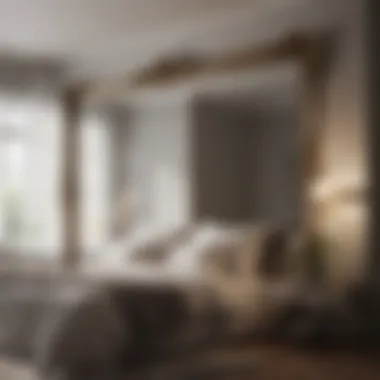
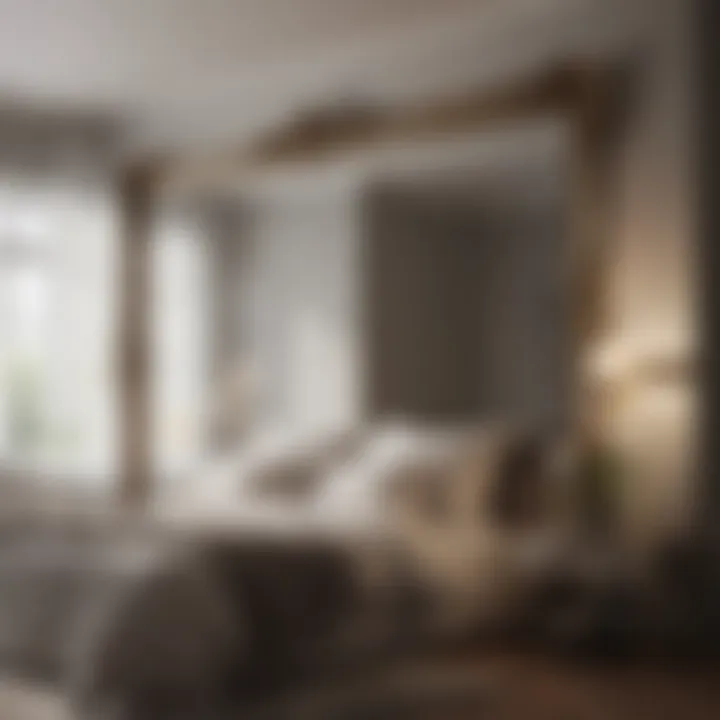
- Mind the Placement: Don't hang mirrors directly above heat sources like radiators. This can cause warping or damage over time. Choose locations away from direct sunlight too, as constant exposure could discolor the frame or the backing.
- Keep Away from High-Traffic Areas: If a mirror is located in a busy part of the room or home, there's a high chance of it getting knocked or bumped. Stability is key.
- Use Scratch-resistant Coatings: For an extra layer of protection, considering mirrors treated with protective coatings can be worthwhile, especially in households with children.
- Handle with Care: When moving or cleaning your mirrors, always use two hands, keeping them supported from underneath. A slip could result in frustrating scratches or even breakage.
In summary, taking steps to properly care for and maintain your mirrors will ensure they continue to enhance your bedroom's aesthetic while standing the test of time. Regular cleaning and taking preventative measures may seem tedious, but they pay off in the long run, allowing you to enjoy the beauty and functionality that mirrors bring.
Innovative Mirror Technologies
In the ever-evolving landscape of home decor, technology has found its way into the reflective surfaces of our lives. Innovative mirror technologies are shaping modern bedroom aesthetics by enhancing functionality and style. These mirrors are not just for reflection anymore; they come loaded with features that cater to the needs of today’s homeowners while elevating the overall look of the bedroom.
Smart mirrors and eco-friendly mirrors are particularly noteworthy in this realm, offering distinct advantages and considerations that deserve a closer look. Sitting at the intersection of form and function, these innovations present exciting opportunities for homeowners to transform their spaces in ways that were previously unimaginable.
Smart Mirrors and Their Features
Smart mirrors have rapidly gained traction, thanks to their ability to integrate technology seamlessly into daily routines. Imagine stepping into your bedroom, and your mirror not only reflects your image but also provides real-time updates regarding the weather, your daily schedule, or even smart home controls. The convenience is astonishing.
Some notable features include:
- Touchscreen Interfaces: Many smart mirrors now come with touch screens that allow users to interact directly with the display, accessing a plethora of information or controlling devices with just a swipe.
- Voice Activation: Imagine how easy it is when mirrors respond to voice commands. Simple requests like adjusting lighting or playing music can be done hands-free, making mornings smoother.
- Fitness Integration: Certain mirrors allow users to follow workout routines with virtual trainers featured right on the surface. This can be particularly motivating for those looking to stay fit from home.
"Smart mirrors blend technology and design, creating an engaging space that speaks to modern needs."
Such advancements not only enhance utility but can also bring a contemporary edge to bedroom decor. Choosing a smart mirror that fits your aesthetic can harmonize technology with style.
Eco-Friendly Mirrors
With increasing awareness about materials and sustainability, eco-friendly mirrors are emerging as a responsible choice for design-conscious homeowners. These mirrors are crafted from sustainable resources and tend to utilize processes that are less harmful to the environment. When selecting eco-friendly options, consider:
- Materials: Look for mirrors made from recycled glass instead of new. These can bring a rustic charm while being kind to the planet.
- Non-Toxic Coatings: Many eco-friendly mirrors employ coatings that don't release harmful volatile organic compounds (VOCs). This is a significant selling point for households concerned about indoor air quality.
- Energy Efficiency: Some eco-friendly mirrors integrate energy-efficient lighting solutions that save on electricity bills while providing perfect illumination.
Incorporating eco-friendly mirrors not only affirms a commitment to sustainable living but can also infuse your bedroom with a unique character that tells a story.
Mirrors and Bedroom Themes
Mirrors in bedroom design serve not only as functional pieces but also as vital elements of aesthetic expression. When thinking about how to enhance the look and feel of a bedroom, the theme is crucial. A carefully selected mirror can tie together a room’s decor, elevate its charm, and even influence how one feels in that space. The key lies in matching mirrors to the existing theme, as well as making considered decisions about placement and style.
Matching with Various Styles
Understanding that themes infuse personality into spaces, mirrors must harmonize with different styles to amplify their effects.
Modern Interiors
Modern interiors are characterized by clean lines, a minimalist approach, and often an industrial feel. This style emphasizes functionality and simplicity, making it a popular choice for many homeowners. Mirrors in modern spaces typically come in sleek, frameless designs or geometric shapes that reflect light, aiding in the illusion of more space. A standout feature can be a large, floor-to-ceiling mirror, as it creates a seamless look that enhances open layouts.
Key characteristic: The absence of excessive decoration.
One benefit of modern mirrors is that they often double as art pieces, with unique shapes adding visual interest. However, their sometimes stark aesthetic can risk seeming cold if not balanced with warmer decor.
Traditional Spaces
In contrast, traditional spaces embrace elegance and timeless charm. Here, mirrors often feature ornate frames, intricate carvings, and classic shapes. They contribute to a warm ambience, suitable for creating a cozy retreat. Vintage mirrors, particularly those with gilded frames, can be focal points that signify sophistication.
Key characteristic: Rich textures and historical references.
Choosing a traditional mirror can bring a sense of nostalgia to a bedroom, appealing to those who cherish classic designs. However, traditional mirrors may require careful integration, as excessive patterns can clash with modern elements.
Eclectic Designs
Eclectic designs welcome a mix-and-match philosophy, showcasing items from various styles that reflect individual taste. Mirrors in this setting aren't bound by a single theme; they can be quirky, bold, or even mismatched in style. A colorful, hand-painted mirror might stand out against muted walls, sparking conversation and joy.
Key characteristic: Personal expression without boundaries.
A significant advantage of eclectic designs is their flexibility, allowing homeowners to showcase their personality. However, the risk lies in the potential chaos that such an unrestricted approach can create, making it essential to find a balance.
Seasonal Decor Considerations
Seasons bring change, and decor should evolve accordingly. Mirrors can change their role throughout the year: in spring, they might reflect light pastels; during autumn, warm earth tones take center stage. Here’s how to adapt mirrors for seasonal vibes:
- Spring: Incorporate mirrors with floral motifs, pairing them with fresh greenery.
- Summer: Opt for light and airy designs that amplify sunlight.
- Autumn: Utilize richer, darker mirror frames that echo the changing leaves.
- Winter: Choose mirrors that reflect warm lighting, creating a cozy vibe.
Adapting mirrors according to the season is a simple yet effective way to keep a bedroom lively and inviting. The interplay between mirror design, bedroom themes, and seasonal changes stands central to creating a cohesive aesthetic and a comfortable space.
Finale
Reflecting on the integration of mirrors into bedroom aesthetics reveals their transformative power. They do not merely serve as a functional piece for checking one’s appearance; their influence extends into realms of ambiance, spatial perception, and personal expression.
Recapping the Importance of Mirrors
Mirrors can be considered the unsung heroes of bedroom design. Their contributions are broad, impacting both style and functionality. For starters, they enhance the flow of natural light and create an illusion of more space, particularly helpful in smaller rooms. A strategically placed mirror can brighten a dim corner or open up a cramped area, allowing the room to breathe. In addition, mirrors can establish a focal point, drawing attention to key design elements like artwork or furniture.
"Mirrors reflect not only our physical selves but also our personal style and creativity. Understanding their importance can elevate any bedroom design."
Furthermore, the psychological effects of mirrors play a significant role. They can alter mood and perception, often invoking feelings of openness or tranquility. For those who utilize their bedrooms not just for sleep but as a haven for relaxation or work, this is vital.
Future Trends in Mirror Design
Looking ahead, the future of mirror design is nothing short of intriguing. The rise of smart home technology has introduced innovative mirror features that enhance user experience. Imagine mirrors equipped with ambient lighting adjustments or smart screens providing time, weather updates, and even guided meditations, all while you prepare for the day.
Moreover, eco-friendly options will continue to emerge, reflecting a growing concern for sustainability. Materials that minimize environmental impact, such as reclaimed wood frames or responsibly sourced glass, are becoming popular among homeowners seeking to balance decor with eco-consciousness
Additionally, the trend of personalization is likely to flourish. Customized mirrors that embody individual styles, colors, and shapes will allow homeowners to inject their personality into their rooms. We might even see unique designs that fuse art with functionality, creating mirrors that are spectacular visual statements beyond just reflections.















